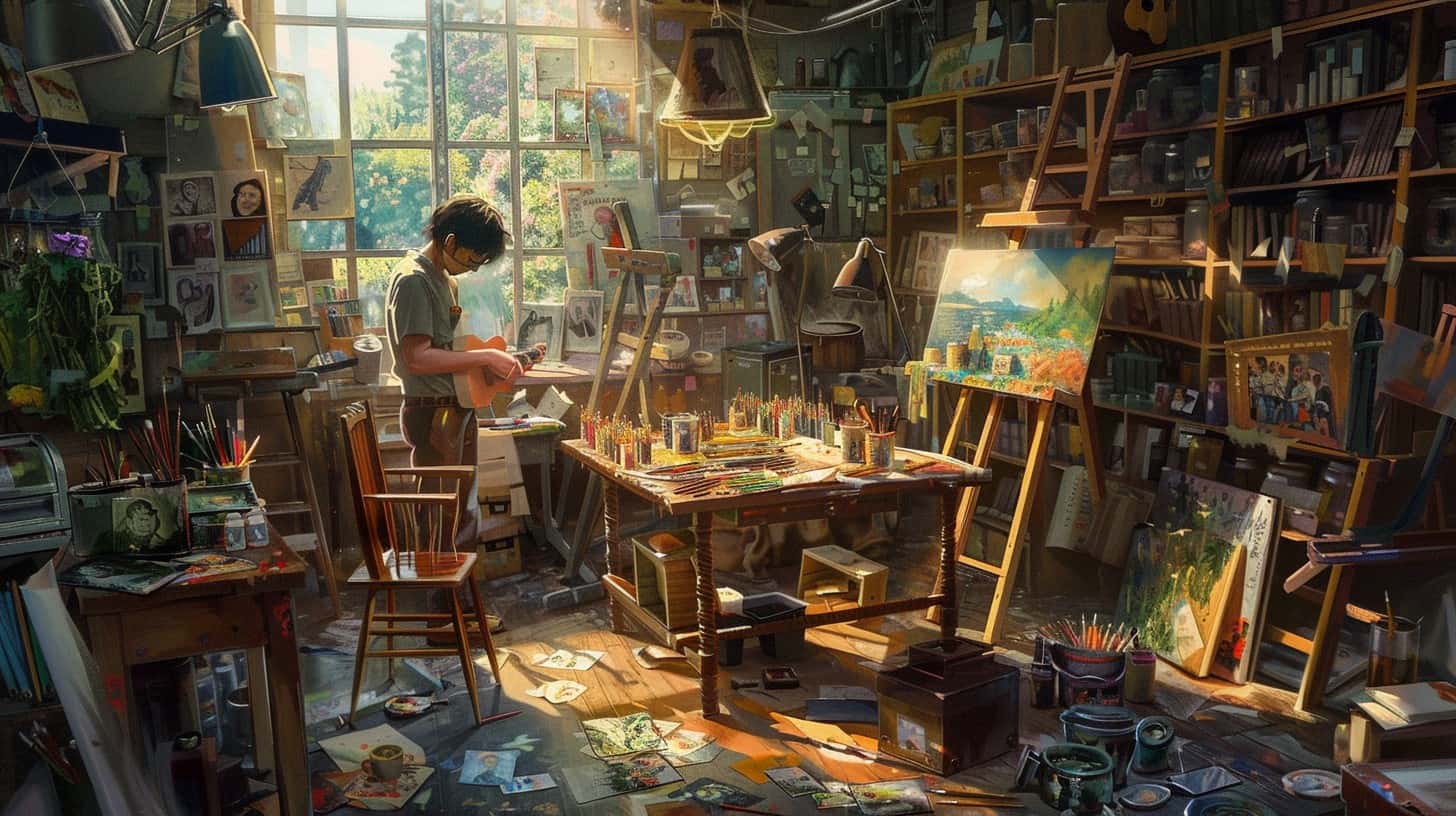Feeling stuck in a rut lately? You’re not alone. Here’s a tidbit for you: creative hobbies can be game-changers for your mental health. This article will guide you through discovering 10 life-changing benefits of diving into creative pastimes.
Ready to get inspired?
Key Takeaways
Creative hobbies boost mental health by improving problem-solving skills and increasing self-confidence.
Activities like painting, digital art, and calligraphy can potentially turn into income streams while offering relaxation and a way to express oneself.
Engaging in creative pastimes enhances creativity by stretching the imagination and presenting new ways of thinking.
Getting started with a creative hobby requires curiosity, basic supplies, and practice to bring ideas to life.
Joining communities or taking classes helps improve skills faster in hobbies such as hand lettering, calligraphy, or digital design.
Table of Contents
Understanding the Importance of Creative Hobbies
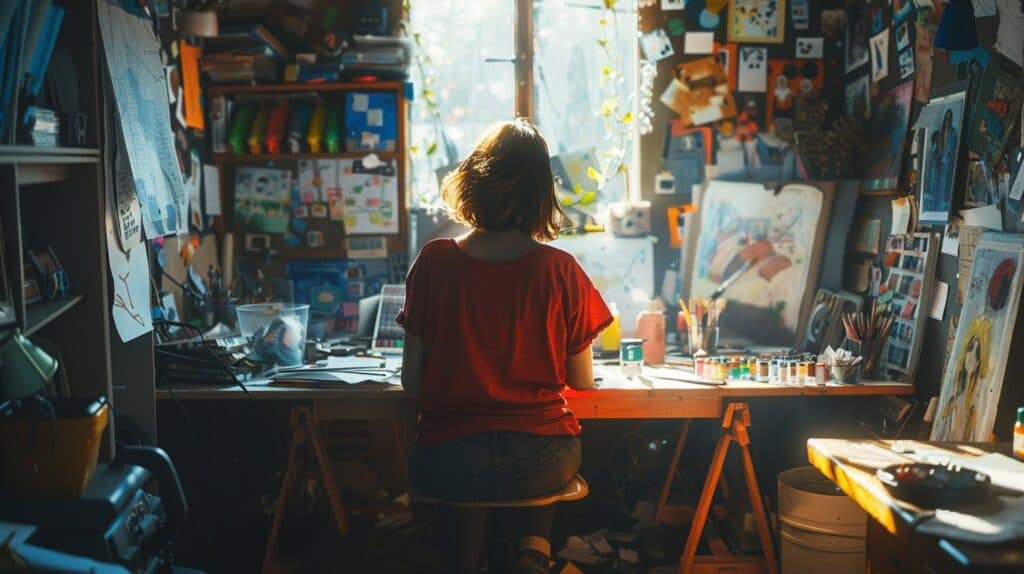
Creative hobbies… they’re like a secret sauce that adds zing to life. They boost your creativity, making everyday problems easier to solve.
Benefits of Creative Hobbies
Diving into creative hobbies like digital painting, knitting, or even soap making can work wonders for your mental and emotional well-being. It’s like hitting the refresh button on your brain—offering a cozy getaway from the daily grind.
You’ll find yourself weaving through challenges with improved problem-solving skills, boosted by the creativity that comes from crafting something with your own hands. Plus, there’s nothing quite like the satisfaction of holding a piece of art you created—it’s a solid boost to self-confidence.
Engaging in activities such as quilting, photography, or playing music not only opens doors for relaxation but also paves the way for self-expression. Imagine translating your thoughts and feelings into colors on a canvas or melodies that dance in the air—it’s pure magic! Moreover, these hobbies can turn into income streams; yes, that Etsy shop isn’t going to open itself.
So, whether you’re gardening under the sun or scribbling away in a bullet journal at night with friends—you’re nurturing not just hobbies but pathways to happiness and maybe even some extra pocket money too.
How Creative Hobbies Enhance Creativity
Creative hobbies throw a curveball at your brain, making it think in new and exciting ways. Every stroke of the paintbrush, every click of the camera, even folding paper into origami shapes… they’re not just actions. They are exercises that stretch your creative muscles, pushing boundaries you didn’t know existed. Your mind gets a workout akin to solving puzzles—it finds fresh solutions and sees ordinary things from extraordinary perspectives.
These activities boost cognitive function while improving memory—akin to giving your brain a personal trainer who also doubles as an inspiring muse. Engaging with diverse materials—be it wool for knitting or digital tools for graphic design—opens up a playground where experimentation is the norm.
Here, mistakes are merely stepping stones to mastery and innovation. The journey through painting landscapes, designing digital art, or writing melodies fosters an environment where creativity blossoms.
Getting Started with a Creative Hobby
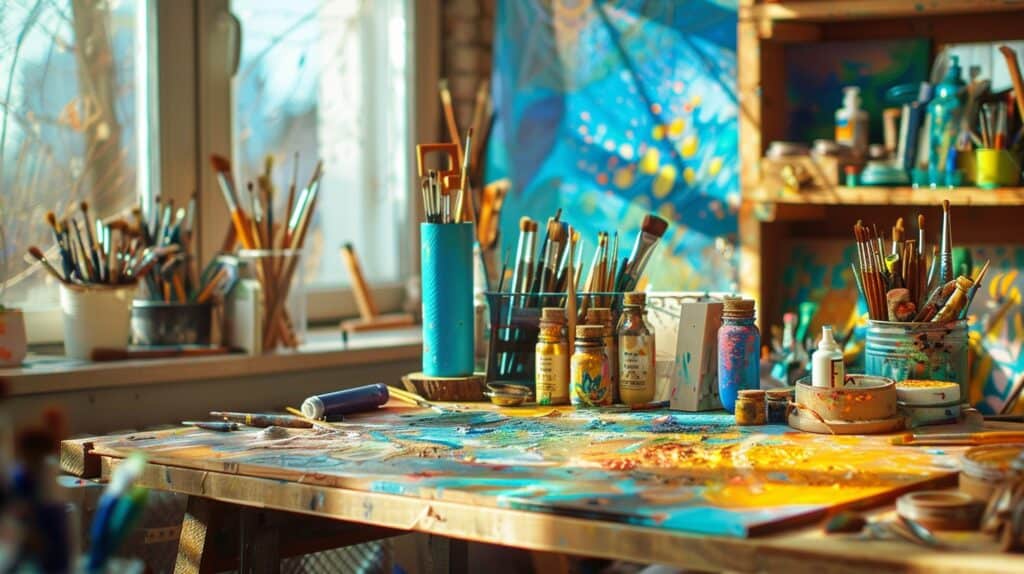
Jumping into a creative hobby starts with a spark–that sudden urge to create something new. All you need is curiosity, some basic supplies, and the willingness to make your ideas come to life.
Choosing the Right Hobby
Picking the perfect hobby feels like finding a needle in a haystack. Start by listing things that pique your interest – maybe it’s flower arranging or wood carving. Catch yourself bored at home? Take this chance to explore indoor activities you’ve never tried.
Maybe crochet hooks and yarn dance through your dreams, or the scent of oil paint gets your heart racing.
Ask friends and family about their hobbies; you might get hooked on something unexpected! The internet is also your best friend here – dive into forums and watch YouTube tutorials on digital illustration, paper folding, or even leather crafting.
Imagine creating something from scratch – how cool would that be? So, grab those needles, brushes, or a digital drawing pad, and let’s turn those sparks of interest into flames of passion.
Gathering Essential Materials and Supplies
So, you’ve chosen a hobby that sparks joy and excitement. Now, it’s time to talk about the nuts and bolts – gathering the materials and supplies you need to get started.
- Start with the basics – Before diving headfirst into advanced tools and gadgets, focus on acquiring essential items. For drawing, this might mean pencils, erasers, and paper. If you’re venturing into digital art, a reliable computer and software like Adobe Illustrator or Photoshop are must-haves.
- Quality matters but doesn’t break the bank – Initially, opt for mid-range products that offer good quality without costing an arm and a leg. You can upgrade your sewing machine or painting brushes as you progress.
- Research is your best friend – Spend time reading reviews and asking for recommendations in online forums or groups related to your hobby. Fellow enthusiasts are often more than happy to share their wisdom on where to find the best deals on fabric scissors or kiln-casting equipment.
- Keep an eye out for sales and discounts – Art supplies, musical instruments, and crafting tools can be expensive. Scour flyers, subscribe to newsletters from craft stores, and don’t shy away from second-hand shops; you never know when a treasure might pop up at half the price.
- Don’t forget about organization – As your collection of threads or yarns grows, so does the need for proper storage solutions. Clear boxes, pegboards for tools, or folders for your sketches can save you from turning your creative space into a chaotic mess.
- Experiment with sustainable options – If your hobby involves materials like paper craft or pottery clay, look into recycled or eco-friendly alternatives. Not only does it benefit the planet but sometimes these materials offer a unique touch to your projects.
- Budgeting is crucial – Keep track of how much you’re spending versus how much use you’re getting out of each item to avoid splurging on things like motion graphics software that’ll just gather digital dust.
- Practice makes perfect – Remember that even though high – quality materials can enhance user experiences in hobbies such as photography or jewelry making, it’s ultimately practice that hones skill over any fancy camera or pliers set.
- Stay updated – The world of creative hobbies is always evolving; new techniques in watercolor painting emerge, while trends in macramé might make a comeback. Magazines focused on particular hobbies often highlight newly released supplies worth investing in.
- Lastly, join classes if possible – Tutors not only guide you through learning basics faster but also give precious advice on essential tools specific to crafts like leatherwork or quilting garments, which could save future frustration (and money).
Gathering what’s needed marks just the beginning of an exciting journey; one filled with learning curves yet immense satisfaction once those first creations start coming to life!
Learning the Basics and Practicing Regularly
Once you’ve got all your supplies, it’s time to dive into the nuts and bolts of your new hobby. Learning the basics and making a habit of practicing can transform those initial squiggles, blobs, or off-tune notes into something truly amazing. Here’s how to kick things off on the right foot:
- Start with tutorials for beginners – Look up online videos, books, or classes that cater specifically to newbies. These resources break down complex skills into manageable chunks.
- Practice makes perfect – Yes, it’s as true for creative hobbies as it is for anything else. Carve out a bit of time each day or several times a week to hone your craft.
- Set small goals – Don’t aim to write a novel in a month or become a master potter over the weekend. Instead, focus on smaller achievements like finishing a short story or creating your first pot.
- Embrace mistakes – They’re not just inevitable; they’re invaluable learning opportunities. Each error teaches you what not to do next time.
- Join a community – Whether online or in the real world, connecting with others who share your interest can provide motivation, inspiration, and helpful tips.
- Record your progress – Keep track of your journey with photos or journal entries. Looking back at how far you’ve come can be incredibly motivating.
- Challenge yourself – Once you’ve got the basics down pat, push yourself out of your comfort zone by taking on projects slightly above your current skill level.
- Ask for feedback – Show your work to friends, family members, or fellow enthusiasts and ask for their honest opinions.
- Adapt – If something isn’t working for you… change it! Maybe an alternate method suits you better, or experimenting with different materials brings unexpected joy.
- Celebrate every victory – Finished that scarf? Nailed that chord progression? Take a moment to pat yourself on the back; you earned it!
Jumping into painting, digital art & graphic design, hand lettering & calligraphy, DIY furniture makeovers — whatever tickles your fancy — just remember: fundamentals first, then practice till the cows come home! It’s this cycle of learning and doing that’ll bring out the best in any budding hobbyist.
Creative Hobby 1: Painting and Drawing
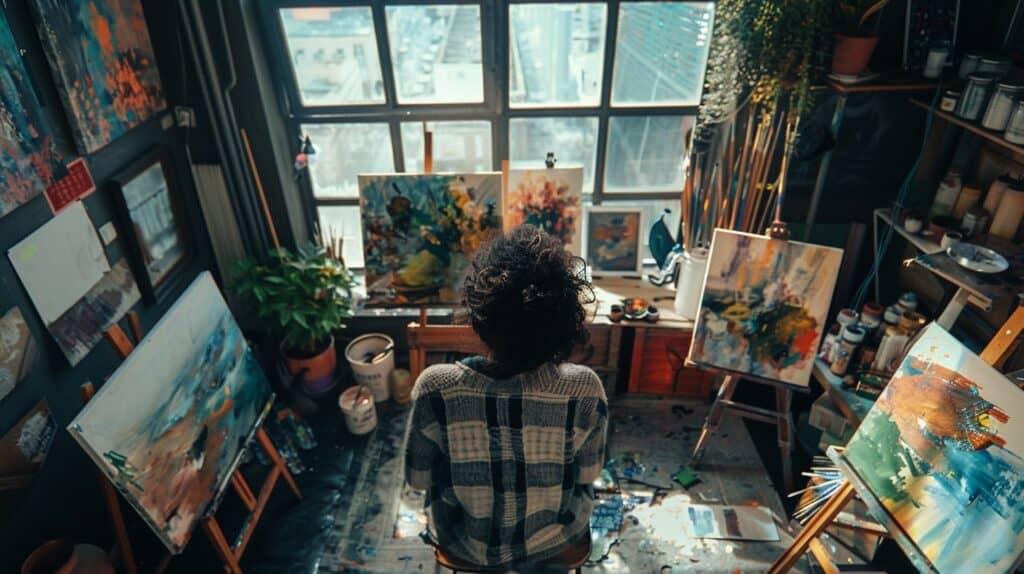
Grab a brush or pencil, and you’re ready to dive into the world of painting and drawing. It’s like opening a door to your imagination—no limits, just pure creation.
Materials and Basics of Painting and Drawing
Jumping into painting and drawing fires up the brain in ways you wouldn’t believe. It’s like giving your mind a workout, boosting memory and sharpening those thinking skills. Let’s dive into what you’ll need and some basics to get you started:
- Sketchbook – Your new best friend. This is where all those wild ideas will first hit the page. Think of it as a diary, but for your art.
- Pencils – Start with a variety pack. Each pencil gives a different line thickness and darkness, perfect for experimenting.
- Erasers – Get both a kneaded and a hard eraser. They’re your back-up plan when things go sideways.
- Brushes – A basic set will do at first… think broad strokes before fine details.
- Acrylic paints – These are great for beginners. They dry quickly and clean up with water, making messes less scary.
- Oil paints – For those feeling adventurous, oil paints offer vibrant colors that blend beautifully… just remember they take ages to dry!
- Watercolor paints – Light, airy, and a bit unpredictable – perfect for letting loose and seeing where the paint takes you.
- Canvas or painting paper – Where all the magic happens! Canvases come pre-stretched and ready; painting paper is great for watercolors.
- Palette knives – Not just for mixing colors… scrape, layer, and add texture to bring paintings to life.
- Digital tools – If pixels are more your style, software like Adobe Photoshop opens up an endless canvas without the cleanup.
- Best-selling kits – For beginners wanting an easier start, best-selling paint by numbers kits offer everything in one box with guided designs to help learn color placement and brush control.
- Inspiration – Look around! Art ideas are everywhere… from the mug on your desk to the sunset outside your window.
Starting with these essentials will put you on solid ground as you begin exploring painting and drawing’s vast landscape—each stroke bringing thoughts to life while clearing the mind, like meditation in motion.
Tips to Enhance Your Painting and Drawing Skills
Now that you’ve got your brushes and pencils ready, let’s dive into how you can take your painting and drawing skills to the next level. It’s all about practice, observation, and a pinch of creativity. Here are some tips to help you improve.
- Set aside time every day for practice. Even if it’s just 15 minutes, it makes a difference. Regular practice sharpens your skills and keeps those creative juices flowing.
- Start with simple sketches before moving on to complex scenes. This builds your confidence and hones basic techniques.
- Experiment with different mediums. Try acrylic painting one day, then switch to water-based paint or gouache painting another day. Each medium can teach you something new.
- Use high – quality materials when you can. Better brushes and paper can transform your art experience and outcome.
- Join a local art class or online community. Learning with others provides motivation and introduces new perspectives.
- Take inspiration from everything around you – outdoor enthusiasts find vibrant subjects in nature, while urban sketching captures the bustling life of cities.
- Study the work of artists you admire. Analyze their techniques in prints or digital media to understand their style and methods.
- Pay attention to light and shadows in real life—it’s crucial for adding depth to your artwork.
- Keep a scrapbook or bullet journal for ideas, doodles, and what inspires you—a goldmine for creativity!
- Enhance your digital art skills by mastering software like Lightroom or exploring UI/UX design principles if that sparks an interest.
- Challenge yourself with projects outside your comfort zone—maybe it’s sculpting with polymer clay or trying papier-mâché for the first time.
- Finally, don’t be afraid to make mistakes—they’re just stepping stones on your path to becoming a better artist.
By embracing these tips, not only will your technical skills grow, but so will your unique artistic voice!
Creative Hobby 2: Digital Art & Graphic Design

Dip your toes into the digital world and watch your art come to life on screen. Digital Art & Graphic Design let you paint, sketch, and design with a click — it’s like magic at your fingertips!
Introduction to Digital Art & Graphic Design
Digital art and graphic design are gateways to a world where creativity knows no bounds. They mix art with technology, allowing you to create anything from stunning illustrations to eye-catching web designs.
You’ll need a few basics to get started – a computer or tablet, some nifty graphic design software, and perhaps a digital pen for that extra precision. It’s like having your own digital canvas, where the possibilities are as limitless as your imagination.
Exploring this field opens up many doors, not just for personal expression, but also for career opportunities. There’s something incredibly satisfying about bringing your ideas to life on the screen.
And with tons of online tutorials and communities out there, learning the ropes is easier than ever. You’re not alone on this journey; there’s a whole community of creatives just waiting to welcome new artists into the fold.
So go ahead—make that leap into digital art and graphic design today!
Steps to Start with Digital Art & Graphic Design
Jumping into digital art and graphic design opens a world of creativity and precision. It’s like learning a new language—but instead of words, you use shapes, colors, and lines. Here’s how to start:
- Pick your tools wisely. A reliable computer and a drawing tablet are your bread and butter. Don’t skimp on these—good tools can make or break your designs.
- Choose the right software. Adobe Photoshop and Illustrator are the go-to programs for many artists. But don’t be afraid to experiment with others like Procreate or Sketchbook to find what suits you best.
- Dive into tutorials galore. The internet is overflowing with free lessons on everything from basic sketches to intricate designs. YouTube, in particular, is a goldmine.
- Start small, dream big. Begin with simple projects to get a feel for your chosen software—think logos, basic layouts, or straightforward illustrations.
- Practice makes perfect…literally. Sketch daily, even if it’s just doodles in a digital notebook. Every line drawn is a step closer to mastering your craft.
- Join online communities. Sites like Behance or Dribbble not only inspire but also connect you with fellow creators who can offer feedback and support.
- Keep up with trends—and break them too! Stay aware of what’s hot in the design world, but don’t be afraid to push boundaries and develop your unique style.
- Save everything you create—even the mess-ups! Tracking progress over time can boost confidence as you watch your skills flourish.
- Feedback is your friend; don’t shy away from it! Constructive criticism can vault your work from good to great.
- Remember: every expert was once a beginner, just like you! Push through the frustrations; every challenge overcome sharpens your abilities.
Next up? Let’s talk about Hand Lettering & Calligraphy—a fantastic way to elevate any project with a personal touch.
Creative Hobby 3: Hand Lettering & Calligraphy
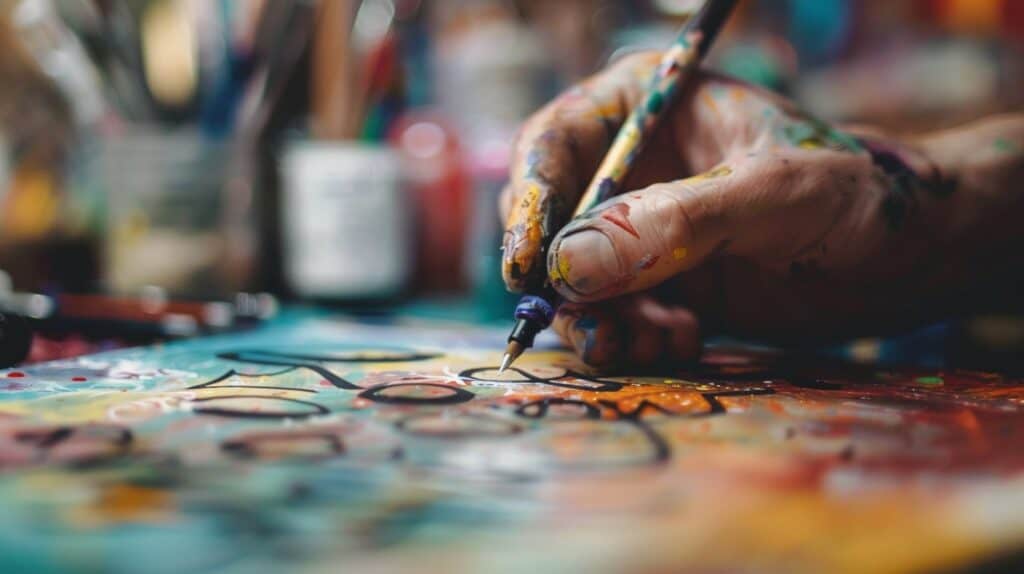
Dive into the world of hand lettering and calligraphy, where your pen brings words to life. It’s not just about writing; it’s art that flows from your fingertips, turning simple notes into beautiful masterpieces.
Basics of Hand Lettering & Calligraphy
Hand lettering and calligraphy turn words into art. They require a steady hand and a creative mind, making every letter a masterpiece. Here’s how to get started:
- Choose your tools wisely. A good quality pen makes a big difference. For beginners, felt tip pens are forgiving and easy to control.
- Paper matters too! Smooth, thick paper prevents ink from bleeding and keeps your letters looking crisp.
- Start with basic strokes. Before you write letters, practice making thin upstrokes and thick downstrokes.
- Learn the alphabet—again. This time, focus on calligraphy fonts or hand lettering styles you love.
- Keep it slow and steady. Rushing leads to wobbly lines and smudges… nobody wants that!
- Embrace your mistakes—they’re part of the process! Plus, erasers are magic for pencil guidelines you’ll draw first.
- Experiment with styles. From block letters to flowing script, find what feels right for you.
- Add some flair with flourishes… those extra swirls and twirls make your writing uniquely yours.
- Practice makes perfect… or at least better! Doodle words while watching TV or waiting on hold.
- Hand Lettering and Calligraphy let you personalize projects in a way that’s truly special—think cards, signs, even your bullet journal!
So grab those pens and let’s create something beautiful today!
Tips to Master Hand Lettering & Calligraphy
So, you’ve dipped your toes into the basics of hand lettering and calligraphy. Now, it’s time to swim deeper and make some real waves with your skills. Let’s dive into how you can master this creative craft.
- Start simple. Don’t run before you can walk. Practice basic strokes, lines, and shapes to build a strong foundation. This is like learning the scales in music before playing a symphony.
- Set realistic goals, just as setting realistic goals is key in mastering hand lettering and calligraphy. Maybe this week, mastering the alphabet is your aim. Next week, tackle numbers.
- Establish a routine because practice makes perfect – or at least way better! Carve out a regular time each day for practice. Consistency is your friend here.
- Share your progress with friends or on social media. Celebrating small victories builds confidence and keeps you motivated.
- Gather different tools and papers to discover what works best for you—experiment with various nibs, inks, and paper types.
- Join a community either online or offline where you can get support, share tips, and stay inspired by others’ work. Remember that joining a community can significantly boost motivation and commitment.
- Learn from the masters by watching tutorials online or taking workshops when possible — there’s always something new to learn!
- Take breaks when needed; sometimes stepping away for a bit helps you come back stronger and see things with fresh eyes.
- Always maintain an open mind for feedback; constructive criticism can be gold when looking to improve your skills.
- Lastly, enjoy the process without getting too hung up on perfection—every stroke brings you one step closer to mastery.
Keep these points in mind as you continue on your journey of hand lettering and calligraphy mastery — it’s supposed to be fun, after all!
Creative Hobby 4: DIY Furniture Makeovers
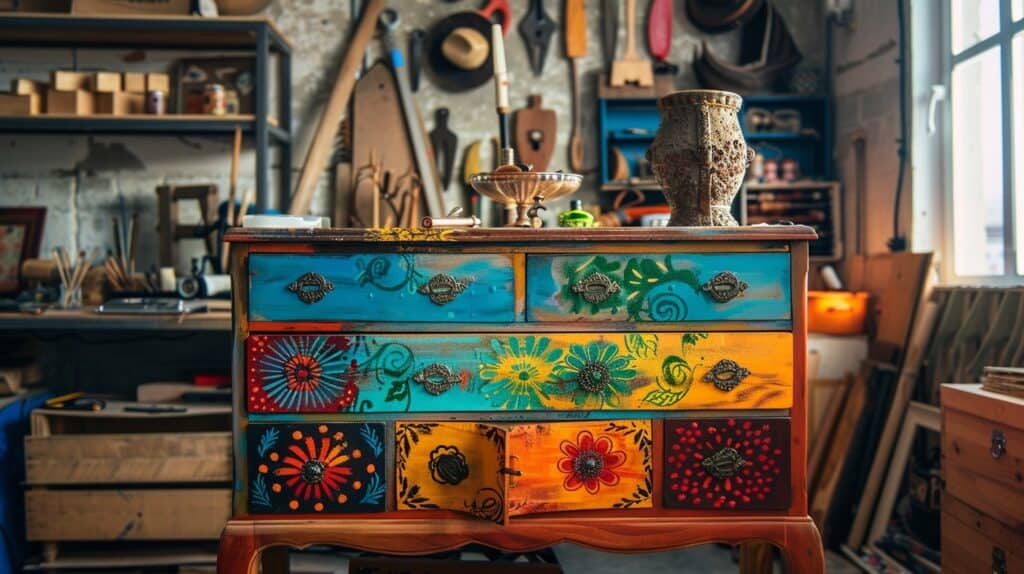
Tired of that old dresser gathering dust? DIY furniture makeovers turn the boring into breathtaking — and we’ll show you how.
Introduction to DIY Furniture Makeovers
DIY furniture makeovers are all about breathing new life into old pieces. It’s a creative way to save money and reduce waste. Plus, you get to learn practical skills along the way.
Imagine turning an outdated chair or a worn-out table into something stunning and stylish! This hobby isn’t just about making your space look better. It’s also a chance to put your stamp on your home.
Starting with DIY furniture makeovers means you’re joining a community of crafters who love to share their transformations. You’ll need some basic tools, paint, and maybe some fabric for upholstering.
The real magic happens when you mix creativity with craftsmanship. Each project brings satisfaction and pride in what you’ve accomplished – not to mention the personalized touch it adds to your décor!
Steps to Start with DIY Furniture Makeovers
Jumping into DIY furniture makeovers can turn old pieces into treasure and boost your sense of accomplishment. With the right steps, you’ll not only transform furniture but also create a space that feels uniquely yours. Here’s how you get rolling:
- Hunt for inspiration – Scope out Pinterest, Instagram, or home decor websites. Get those creative juices flowing by seeing what others have done.
- Choose the right piece – Start with something manageable. Maybe it’s a chair from a thrift store or a tired-looking table from your attic.
- Gather your tools and supplies – You’ll need basics like sandpaper, paintbrushes, primer, paint, and perhaps some new hardware for knobs or pulls.
- Prep the area – Make sure you have enough space to work without making a mess of your living area. Lay down newspapers or a drop cloth to catch spills.
- Clean the piece thoroughly – Years of dust and grime can hide under that dated finish. A good wipe down ensures your new paint sticks better.
- Sand it down – This step is crucial for removing old finishes and smoothing out any imperfections.
- Apply primer – It might seem like an extra step but think of it as setting the stage for a show-stopping piece.
- Paint away! Choose a color that speaks to you—bold, pastel, or maybe even metallic for that glam look.
- Finish with a sealant – Protect your hard work from chips and wear with a clear sealant meant for furniture.
- Add new hardware if needed – Sometimes all an old dresser needs is some fancy new knobs to bring it into this decade.
Remember, this process isn’t just about saving money; it’s about putting your stamp on your living space—creating something beautiful while enjoying every brush stroke along the way!
Creative Hobby 5: Photography
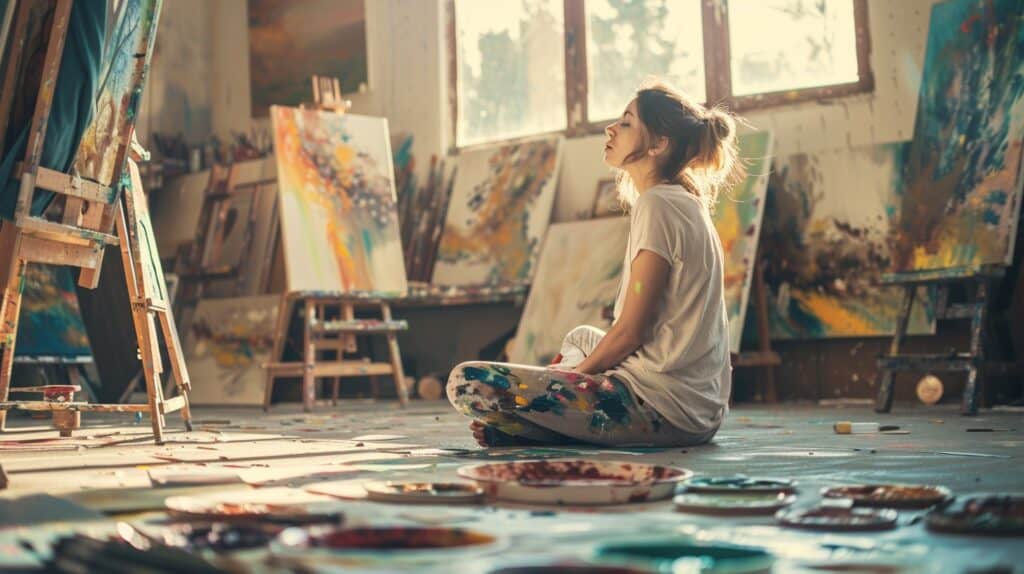
Snap a picture, freeze a moment. Photography lets you capture the world through your eyes, telling stories without words.
Basics of Photography
Diving into photography requires a keen eye and a dash of creativity. Let’s break down the essentials to get you started on this visually stunning journey.
- Understand your camera – Every photographer’s journey begins with their most faithful companion: the camera. Get familiar with its features, buttons, and settings. Playing around with it can be half the fun!
- Master the exposure triangle – Exposure is all about balancing aperture, shutter speed, and ISO. Think of it as finding the sweet spot where light and motion meet to create magic.
- Rule of thirds – Imagine your image is divided by two horizontal and vertical lines. Placing key elements along these lines or at their intersections makes for a more balanced composition.
- Experiment with lighting – Photography is painting with light, after all. Notice how different times of day change a scene’s mood. Early morning and late afternoon often offer the softest light.
- Play with perspective – Crouch down low or find a high vantage point. Changing your viewpoint can turn an ordinary scene into an extraordinary photo.
- Focus on composition – A well – composed photo draws the viewer’s eye naturally through the picture. Use leading lines, framing, and contrast to make your subject stand out.
- Capture emotion – Photos that stir feelings connect better with viewers. Whether it’s a candid laugh or a serene landscape, strive to evoke emotion in your work.
- Practice editing – Tweaking contrast, brightness, saturation, and other settings can help enhance your photos’ impact significantly.
- Share your work – Join online communities or local clubs where you can showcase your photos, receive feedback, and learn from others.
- Photography isn’t just about snapping pictures; it’s about capturing moments that tell stories without words. Each click of the shutter offers a chance to see the world in a new light—literally! Keep practicing, be patient with yourself, and most importantly, enjoy every step of this creative journey.
Tips to Improve Your Photography Skills
Snapping a great photo feels like capturing a piece of magic. It’s all about the right angle, light, and that split-second moment. Here are some tips to elevate your photography game, turning simple shots into breathtaking art.
- Master the basics of your camera – Get cozy with your camera’s settings. Learn what each button does. Experiment with shutter speed, aperture, and ISO. The more you know, the better your photos will be.
- Play with lighting – Good lighting can make or break a photo. Notice how different times of the day change your subject’s appearance. Morning light gives soft, warm photos; midday light is bright but can cast harsh shadows; and evening light adds drama.
- Rule of thirds – Imagine dividing your photo into nine equal segments by two horizontal and two vertical lines. Try placing points of interest along these lines or their intersections. This technique helps balance your shot and draw the viewer’s eye across the image.
- Focus on composition – Before clicking, ask yourself: “What story do I want to tell?” Arrange elements in the frame to guide the viewer through the story you’re telling.
- Experiment with perspectives – Take shots from different angles and heights to find unique perspectives on common subjects.
- Capture candid moments – Posed photos are fine, but candid shots often hold more emotion and story. Capture people when they’re not paying attention for genuine expressions.
- Practice patience – Sometimes you have to wait for that perfect moment when everything aligns just right… And click!
- Use editing software sparingly – While it’s tempting to heavily edit photos, try to keep adjustments minimal for a natural look unless you’re going for something highly artistic or surreal.
- Join online photography communities – Share your work for feedback and support, while learning from others’ experiences too.
- Keep learning – Photography is an ever – evolving field, with new techniques always around the corner.
And here’s a sparkly idea: Custom diamond art kits made from a photo offer a unique way to share your best shots with friends and loved ones! Turn those magical moments into dazzling diamond art—a fun twist in showcasing your creativity beyond traditional prints or online albums.
Creative Hobby 6: Jewelry Making
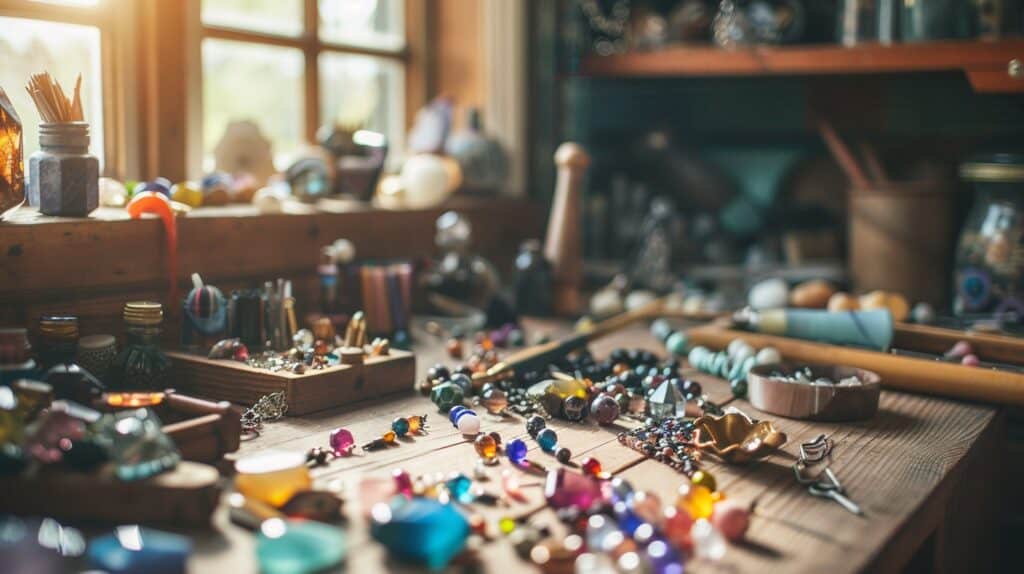
Jewelry making turns ordinary beads and metals into treasure. You’ll feel like a magician, transforming simple materials into your own sparkling creations.
Introduction to Jewelry Making
Diving into jewelry making starts with picking your path. You might lean towards beadwork, get hooked on wire wrapping, find metalwork fascinating, or play with polymer clay. Each technique offers its own world of creativity and expression.
Picture getting lost in the shine of beads or bending wire into intricate designs. The possibilities are endless.
Starting this hobby boosts more than just your creative muscles. It brings mental well-being to the forefront, pumps up your self-confidence, sharpens problem-solving skills, and leaves you with a hefty sense of accomplishment.
Imagine crafting something stunning and thinking, “Wow, I made that!” Plus, it’s a fantastic way to meet people who share your interests through clubs or workshops—turning solitary crafting sessions into moments of connection and community building.
Steps to Start with Jewelry Making
Now that you’ve got a taste of what jewelry making involves, let’s dive into how you can start crafting your own beautiful pieces. It’s a journey from gathering supplies to creating something that sparkles. Here’s your roadmap:
- Get familiar with the basics. Spend some time learning about different materials and techniques. Online classes and resources are golden for this.
- Collect your tools and materials. You’ll need pliers, wire cutters, beads, clasps, and wire to start. Don’t forget, patience and creativity are key here too!
- Start small. Begin with simple projects like beaded bracelets or earrings. This helps you get comfortable without getting overwhelmed.
- Watch tutorials—lots of them. There’s a wealth of knowledge online that can guide you through the process step by step.
- Practice makes perfect… well, almost perfect! The more you work on your craft, the better you’ll get at it.
- Join a community—whether online or local classes for jewelers-to-be like yourself. Sharing tips and tricks with others can be super helpful.
- Give yourself challenges as you get more comfortable—try working with different materials or complex designs.
- Be patient; every piece won’t be a masterpiece right away, but the satisfaction of seeing your progress is unmatched.
- Create meaningful gifts for family and friends—it’s a great way to spread love and showcase your new skills.
- and finally: Keep experimenting! With each piece, try something new to flex those creative muscles.
Starting out in jewelry making requires attention to detail and an eagerness to learn—but hey, that’s part of what makes it so rewarding! As you grow more skilled, remember the joy comes not just from the final product, but from the process itself… So go ahead, dive in headfirst into this sparkling hobby!
Creative Hobby 7: Music
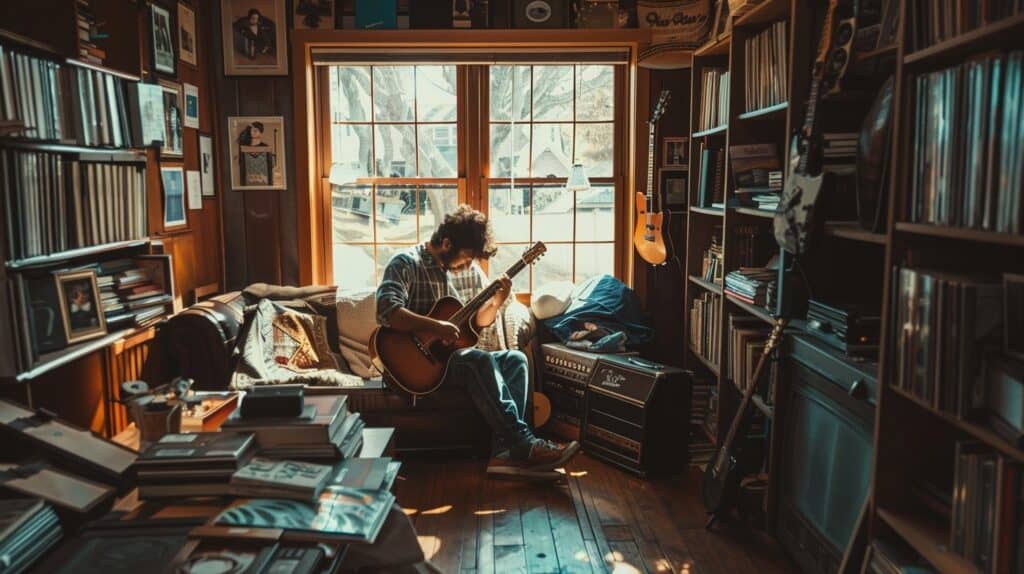
Strumming a guitar, tickling the ivories, or belting out your favorite tunes – music has a way of speaking directly to our souls. It’s not just about hitting the right notes; it’s about expressing what words alone can’t capture… and who knows? You might just find your rhythm in the process.
Introduction to Music as a Hobby
Music as a hobby opens doors to improved mental well-being and sky-high self-confidence. It’s not just about hitting the right notes or mastering an instrument; it’s a journey into self-expression.
Whether you’re singing, songwriting, or playing instruments—each chord strikes a deeper connection within. This creative outlet isn’t limited to solo acts, either. Imagine jamming with friends, joining clubs, or participating in workshops—it’s social interaction at its best.
The beauty of music lies in its diversity and accessibility. You don’t need expensive gear to start; often, what you have will do just fine. The key? Start with what excites you—be it strumming a guitar, tickling the ivories on a piano, or crafting your own songs.
As many find out, this passion can morph into more than just a pastime; for some, it paves the way to careers or businesses centered around their love for music. Opportunities abound for expression, relaxation—and yes—even making some extra cash on the side if that’s your tune!
Tips to Enhance Your Musical Skills
Diving into a musical hobby can boost your mental well-being, self-confidence, and problem-solving skills. Keeping the beat going means constantly learning and improving. Here’s how you can sharpen those musical abilities:
- Set realistic goals: Small wins keep you motivated. Think about mastering a new song every month.
- Establish a routine: Practice makes perfect, so make time for music every day—even if it’s just for 15 minutes.
- Share your progress with friends or family: It’s like showing off your newest dance moves but with instruments or vocals.
- Join a community of musicians: Nothing beats the feeling of jamming with others who share the same passion.
- Listen to lots of music: All genres welcome! It’s like being a culinary critic but for tunes.
- Record yourself playing or singing: Playback might surprise you—spotting what needs work is half the battle won.
- Attend workshops or classes: There are secrets only a seasoned pro can spill—grab them!
- Experiment with different genres and instruments: Why stick to guitar when the ukulele awaits?
- Read about music theory: Okay, not everyone’s cup of tea, but knowing chords and scales does wonders.
- Create a dedicated space for practice: Make it your fortress of solitude where melodies flow unrestricted.
Each step forward in music is like adding another layer to your creative cake—deliciously complex and uniquely yours.
Creative Hobby 8: Sculpting with Recycled Materials
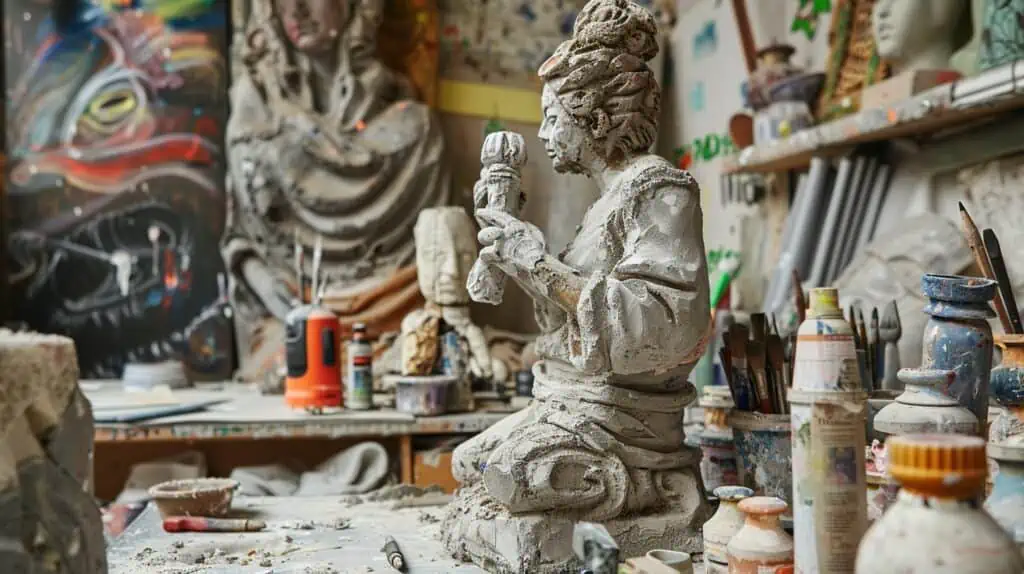
Turning trash to treasure has never been more fun—sculpting with recycled materials gives “second life” a whole new meaning. Dive into an eco-friendly creative journey where your everyday throwaways become the stars of the show.
Basics of Sculpting with Recycled Materials
Sculpting with recycled materials is not just a blast; it’s a step towards saving our planet. You’re playing a superhero role by giving new life to what others might call trash. Let’s dive right into the basics, shall we?
- Start your eco-friendly journey by scouting your home or hitting up the local recycling center for gems—think old magazines, broken electronics, or even those take-out containers you were about to toss.
- Essential tools are next on the list. Grab some scissors, glue, and wire—you’ll be surprised how far these can take you in your sculpting adventures.
- Get inspired! Sometimes, a pile of recyclables looks like…well, a pile of recyclables. But squint a little—see that old keyboard? That could be the next big robot sculpture sensation.
- Sketch it out. Even if drawing isn’t your forte, jotting down a rough idea can help guide your masterpiece-in-the-making.
- Safety first! Gloves and goggles might make you look more like a mad scientist than an artist, but trust me, they can save you from unwanted nicks or pokes.
- Learn basic techniques through online tutorials or books focused on recycled art. There’s a treasure trove of information out there waiting for you.
- Experiment with different materials to see what works best together. Plastic bottles can become elegant swans, while metal cans transform into quirky robots.
- Join online communities or local groups passionate about recycled art. Sharing ideas and getting feedback will fuel your creativity even more.
- Remember, mistakes are just stepping stones to greatness in this game of recycled sculpting—embrace them!
- Lastly, show off your creations! Whether it’s social media or an arts and crafts fair, shine the spotlight on your eco-friendly sculptures.
Every soda can saved from the landfill and every piece created tells a story—not just of artistic triumph, but also of environmental heroism.… Who knew being green could look so good?
Steps to Start with Sculpting with Recycled Materials
Now that you’ve got the basics down, let’s dive into how to get started with sculpting using recycled materials. This journey is all about turning what some might see as trash into incredible treasures.
- First up, gather all the discarded items you can find. Think plastic bottles, old magazines, broken electronics – the sky’s the limit! These will be your main sculpting materials.
- Hunt for tools around your house that can help in sculpting. Scissors, glue, maybe even a small saw. Remember, safety first!
- YouTube and Pinterest are gold mines for tutorials. Look for videos and step-by-step guides tailored for beginners.
- Start simple. Try creating something small like a flower or a bird. This will give you a feel for the materials and tools.
- Practice makes perfect… well, almost! Don’t get discouraged if your first few attempts don’t turn out as expected. Keep trying.
- Join online communities of people who also love sculpting with recycled materials. They’re great places to ask questions, share your work, and get inspired.
- Once you’re comfortable with basic projects, challenge yourself with more complex ones.
- Share your creations on social media or at local art fairs or exhibitions – feedback is always valuable!
- Always be on the lookout for more materials to add to your collection – interesting finds can come from the most unexpected places.
- Lastly, have fun and let your creativity run wild! There’s no right or wrong way to do this; it’s all about expressing yourself and enjoying the process.
Creative Hobby 9: Creative Writing
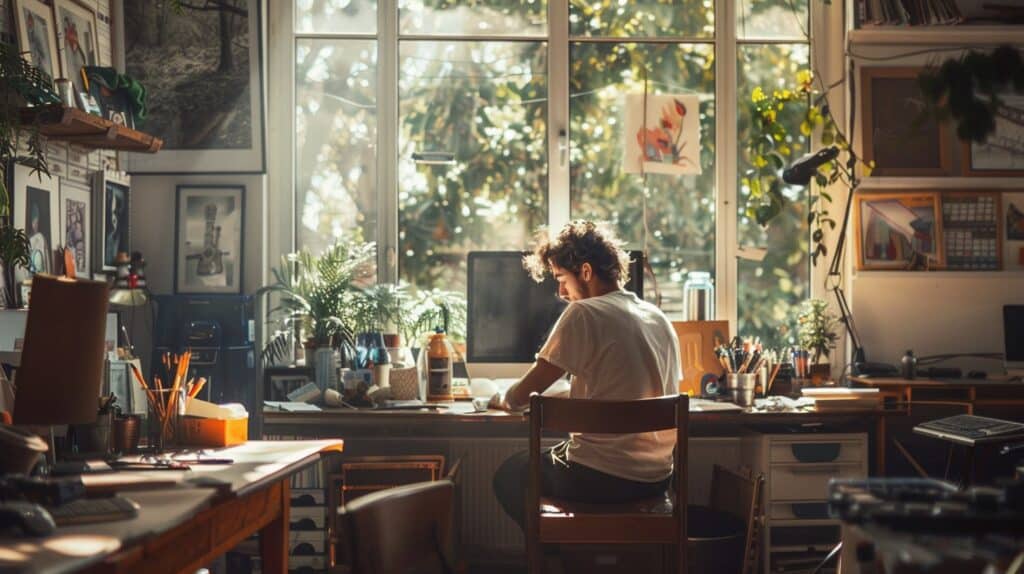
Creative writing lets you explore worlds beyond imagination, one word at a time. It’s a journey where each sentence can unlock new adventures…
Introduction to Creative Writing
Diving into the world of creative writing opens a treasure chest of possibilities. It’s where thoughts and emotions transform into words on a page, creating vivid pictures in readers’ minds.
This hobby isn’t just about putting pen to paper; it’s an art form that engages your imagination, letting you explore various genres like poetry, short stories, and novels. Whether you’re scribbling in a journal or typing on a screen, each word is a step towards expressing yourself more fully.
Creative writing acts as a window to your soul, offering a unique blend of self-expression and artistic exploration. It’s like having conversations with invisible friends—your characters—that live in your mind.
Beyond just killing boredom or reducing stress, this activity can significantly boost your mental health. Plus, anyone can pick up creative writing, regardless of age or background.
So why not grab that notebook or laptop? Your next masterpiece awaits the rhythm of your thoughts turned into prose or verse—it’s time to let those stories out!
Tips to Improve Creative Writing Skills
So, you’ve dipped your toes in the captivating pool of creative writing. Now, let’s swim further and explore how to sharpen those writing skills. Imagine transforming your thoughts into stories that tug at heartstrings or spark laughter. Ready? Let’s dive into some tips that will take your creative writing from good to great.
- Read, read, and then read some more. Sounds simple, right? But the more you read, the better you understand different styles, voices, and genres. It’s like having a conversation with the world’s best writers without leaving your cozy nook.
- Write every day. No excuses. It doesn’t have to be a chapter of a novel; even jotting down thoughts in a journal counts. The goal is to make writing as natural as breathing.
- Play with words. Try out new vocabulary that you’ve come across in your reading adventures. It’s like adding new colors to your palette – who knows what masterpiece you’ll create?
- Seek feedback…and actually listen to it! Share your work with friends or join a writer’s group online. Fresh eyes can spot what you might have missed and provide the encouragement to keep going.
- Rewrite ruthlessly but lovingly. Your first draft is just that – a draft. Polish it until it shines bright, cutting out anything that doesn’t serve the story well.
- Set challenges for yourself: enter competitions, set word count goals, or experiment with different genres and perspectives (ever tried writing from the point of view of a spoon?).
- Check out online tutorials or local workshops to learn new techniques and broaden your horizons—plenty of resources await those willing to seek them out!
- Immerse yourself in emotions—yours and others’. Writing with emotional depth requires understanding feelings deeply; sometimes this means exploring your own or empathizing with others’ experiences.
- Get technical—understand the basics of plot structure, character development, setting scenes… There’s an art to arranging words on a page so they transport readers to another world.
- Finally, bring something special to what you write; infuse your personality into it because nobody sees the world quite like you do.
Remember—a journey of a thousand pages begins with a single word (or something like that). Every great writer started somewhere; why shouldn’t it be here and now for you? Keep pushing forward; blank pages are just playgrounds for your imagination!
Creative Hobby 10: Pottery
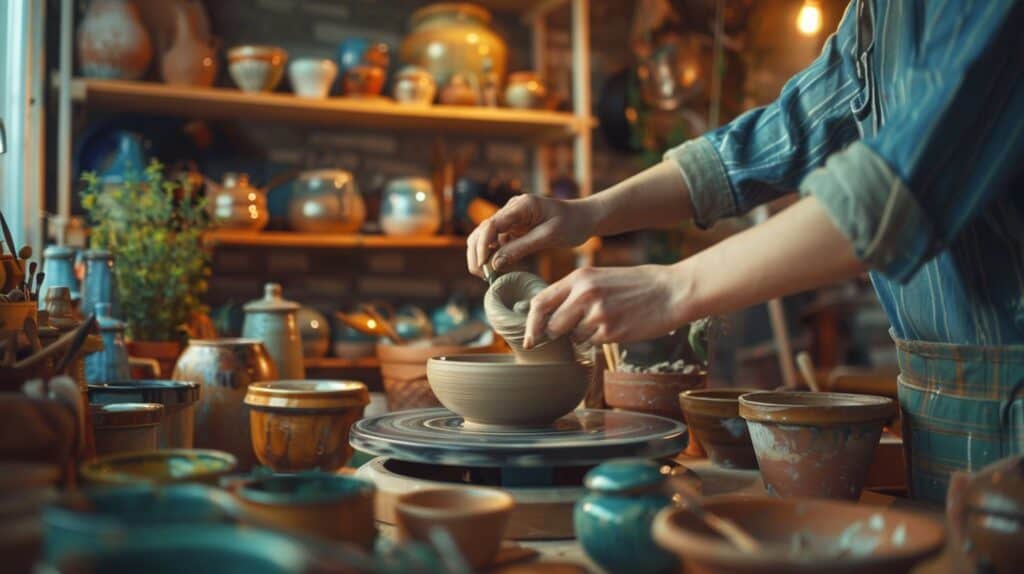
Pottery gives you the chance to get your hands dirty and create something beautiful out of mud. It’s like magic – turning a lump of clay into a masterpiece with just your hands and imagination.
Basics of Pottery
Dive into pottery and find yourself shaping clay into wonders with your own hands. This craft combines art and earth, allowing you to create both functional and decorative pieces that carry a piece of your soul.
- Choose the right clay. Different projects need different types of clay. For example, stoneware is great for dishes, while porcelain is perfect for delicate sculptures.
- Get familiar with hand – building techniques. These include pinching, coiling, and slab building. Each method has its charm and purpose.
- Wheel throwing is another exciting aspect. It’s like a dance between your hands and the clay on the spinning wheel—truly mesmerizing.
- Don’t forget slip casting – a technique where liquid clay pours into molds to shape intricate designs. It’s a bit like magic when you open the mold to see what you’ve created!
- Glazing adds color and finish to your work. Choosing glazes is like picking out the perfect outfit for your pottery—it highlights the best features.
- Firing is crucial—it transforms soft clay into durable ceramic. Whether it’s in an electric kiln or an old-school wood fire, this step gives your piece its strength.
- Practice makes perfect. Sounds cliché, but it’s true here more than ever! The more you work with clay, the better you’ll understand its whims and ways.
- Cleanliness matters in pottery too! Keeping your workspace tidy helps prevent accidents and mix – ups with materials.
- Always be open to learning new methods… Pottery has deep roots in history, yet there’s always something new to discover or a fresh twist on traditional techniques to try.
- Lastly, patience is key… Great things take time – from molding your piece to waiting for it to dry completely before firing.
Jumping into pottery can be as calming as it is rewarding; it’s therapy that results in tangible reminders of moments spent at the wheel or table—each crack, each glaze telling its story.
Steps to Start with Pottery
Pottery starts with clay and vision. It’s a journey from mud to masterpiece that pumps creativity through your veins. Here’s how you can get your hands dirty and your spirit lifted with pottery:
- Find the right clay. There are different types—earthenware, stoneware, porcelain. Each has its own charm and challenge.
- Get the necessary tools. A wheel for throwing, tools for carving, sponges for smoothing—you’ll need these to shape your dreams.
- Learn the basics of hand-building and wheel-throwing. YouTube is a treasure trove of tutorials; local workshops can be golden too.
- Practice wedging—the art of preparing clay by kneading it to remove air bubbles and ensure consistency.
- Explore different techniques like slip casting, glazing, or raku firing—each opens a new door in the pottery world.
- Create something simple to start with… like a bowl or a mug. These projects help you grasp the fundamentals without overwhelming you.
- Experiment with glazes. Colors can breathe life into your work in ways you never imagined.
- Embrace mistakes—they’re lessons in disguise and will guide you better than any textbook ever could.
- Connect with other potters; they’re a wellspring of inspiration and advice… plus, swapping stories over clay-stained tables is always fun!
- Keep practicing! Pottery demands patience, but rewards you with creations that are truly yours—imperfectly perfect expressions of who you are.
So go ahead—give pottery a whirl! With some clay in your hands and fire in your heart, there’s no telling what beautiful things you’ll bring into the world.
Turning Your Creative Hobby into a Career or Business
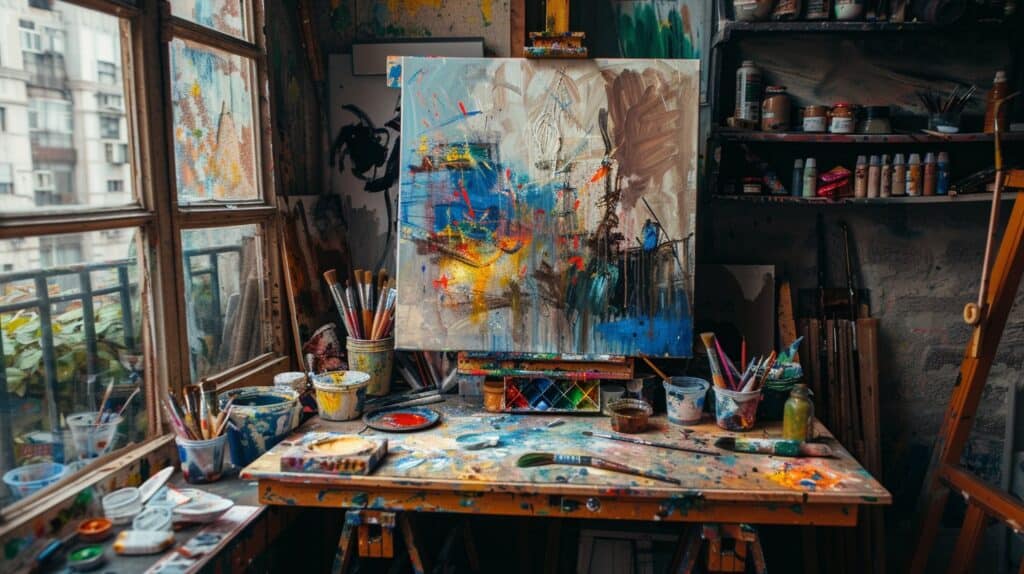
Many people dream of turning their passion into a paycheck. Imagine making money from painting, digital art, or even candle making. It’s possible! Start by showcasing your work online or at local events.
Social media platforms are great for artists to get noticed. Also, consider opening an online shop. Sites like Etsy are perfect for selling handmade items.
Networking is key in the creative world. Attend workshops and join groups related to your hobby. You’ll meet others who share your interests and may find opportunities you didn’t know existed.
Always be ready to learn new things and improve your skills—weaving, pottery, photography—you name it! Success comes from combining creativity with hard work and smart marketing strategies.
Staying Motivated and Committed to Your Creative Hobby

Staying on top of your creative game can feel like juggling with six balls in the air—exciting but tricky. Start by setting goals that fit snugly into your real-life schedule, not the other way around.
Think baby steps, not leaps and bounds. Got a passion for knitting or maybe digital art? Clock in some practice every day, even if it’s just for 15 minutes before bedtime.
Sharing your journey can add a layer of fun you didn’t know was missing. Snap pics of your pottery projects or those intricate paper quillings and post them online. Friends’ cheers and likes can be surprisingly energizing! And don’t forget to mingle—online forums, local clubs, or classes are perfect spots to meet fellow enthusiasts who speak your creative language.
They say joy shared is doubled; well, so is motivation!
FAQs About Creative Hobbies
Why should I pick up a creative hobby?
Well, diving into hobbies like crocheting or oil painting isn’t just about killing time. It’s like opening a door to a whole new world where stress takes the back seat, and joy rides shotgun. Imagine turning yarn into cozy blankets or transforming blank canvases into masterpieces – it’s pretty magical.
Can creative hobbies really change my life?
Oh, you bet! From knitting to making glass sculptures, these aren’t just activities; they’re your ticket to feeling more relaxed and happy. Picture this: You’re focusing on creating something beautiful with your hands – that’s when worries start fading away. Plus, sharing your creations can boost your confidence sky-high!
Are there creative hobbies suitable for older men too?
Absolutely! Age is just a number when it comes to creativity. Whether it’s wood burning designs onto furniture or getting lost in the intricate folds of bonkei landscapes, there’s something out there for everyone. These activities are not only fun, but also great for keeping the mind sharp.
What if I’m not naturally artistic?
Hey, no worries! The beauty of creative hobbies lies in their ability to welcome everyone – yes, even those who think they can only draw stick figures! Ever tried bullet journaling or photomanipulation? They’re perfect gateways into creativity without needing you to be the next Van Gogh.
I live in an apartment; what hobby could I possibly do?
Space shmace… How about diving into the world of felted fiber art or trying your hand at nail art? Or maybe explore quilting? These don’t need much room but offer heaps of satisfaction and fun.
Will these hobbies break my bank?
Not necessarily! Sure, some folks might splurge on top-notch bobbins or fancy fabrics, but starting small is totally okay too—think crewel embroidery with basic thread or experimenting with paper folding techniques from old magazines lying around—creativity doesn’t have a price tag.
